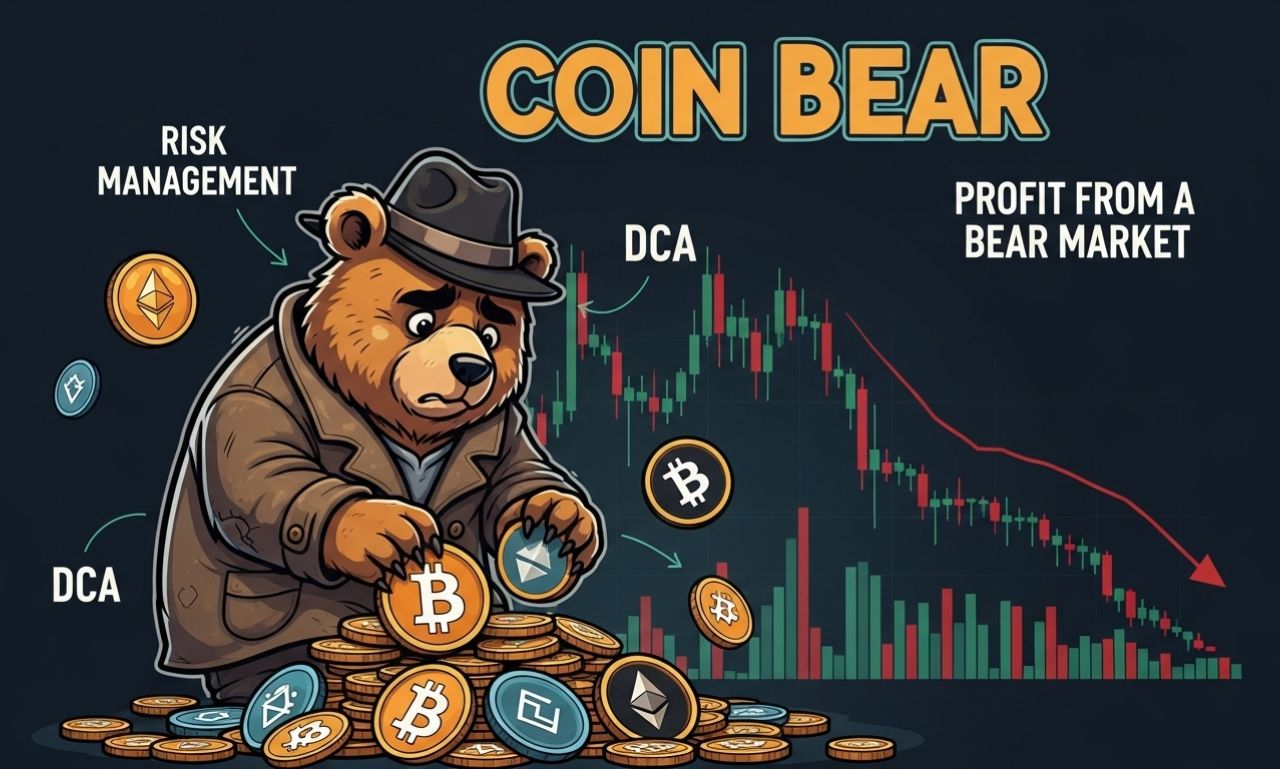The narrative in the exciting, high-stakes world of cryptocurrencies is frequently driven by the “bulls”—the bullish investors who push prices to unimaginable heights. However, there is a bear for every bull. The phrase “coin bears” is more than simply a colloquial word; it refers to a particular, potent, and frequently wise market emotion that has the ability to shape the course of digital assets for months or even years. For everyone who is serious about succeeding in the unstable cryptocurrency ecosystem, it is not just a talent but also a requirement to comprehend the coin bear’s attitude, its causes, and, most importantly, how to tactically respond to it.
The concept of bear markets in cryptocurrencies will be thoroughly examined in this extensive tutorial. We will discuss what it means to be a coin bear, the psychological and fundamental factors that contribute to protracted downtrends, and offer a practical survival guide that will help you safeguard your portfolio and possibly come out stronger when the market cycle inevitably comes around.
What Exactly is a “Coin Bears”? Defining the Sentiment
“Coin bears” are traders or investors that predict that the price of a particular cryptocurrency or the entire cryptocurrency market will drop. This negative perspective can be either short-term (predicting a decline following a rise) or long-term (foretelling a bear market, which is a prolonged period of declining prices).
There are various ways in which the bearish sentiment appears:
- Selling Holdings: A bear might sell their assets to realize profits or prevent further losses.
- Short Selling: More advanced traders may engage in short selling, a practice where they borrow an asset to sell it at the current price, hoping to buy it back later at a lower price to return it, pocketing the difference.
- Increasing Cash Reserves: Bears often convert their crypto into stablecoins or fiat currency, preferring to hold liquid, non-volatile assets while waiting for better entry points.
- Spreading Pessimistic Analysis: Bears actively voice their negative forecasts through social media, research reports, and forums, influencing broader market sentiment.
Differentiating between a bear market and a straightforward market correction is essential. A correction is a brief drop in price, usually between 10% and 20%, from a recent top. It is frequently regarded as a constructive consolidation of a broader bull trend. On the other hand, a bear market is a protracted period of falling prices, usually characterized by a 20% or greater decline from recent highs that lasts for many months or more and is marked by widespread pessimism and unfavorable investor sentiment.
The Anatomy of a Crypto Coin BearsMarket: Key Triggers and Catalysts
Bear markets for cryptocurrencies don’t emerge overnight. Usually, a combination of psychological, industry-specific, and macroeconomic reasons sets them off.
1. Macroeconomic Pressures
Cryptocurrency is no longer an isolated asset class. It has become increasingly correlated with traditional risk-on assets like tech stocks.
- Rising Interest Rates: When central banks raise interest rates to combat inflation, borrowing money becomes more expensive. This reduces the liquidity in the market and makes high-risk, high-reward investments like crypto less attractive compared to yield-bearing, safe assets like government bonds.
- High Inflation: While some tout crypto as an inflation hedge, severe inflation often causes investors to flee all speculative assets, seeking stability instead.
- Geopolitical Instability: Global tensions and wars can create risk-off environments, prompting investors to sell volatile holdings and seek safe havens.
2. Industry-Specific “Crypto Winters”
The crypto industry has its own unique set of problems that can trigger deep bear markets, often referred to as “crypto winters.”
- Major Project Failures: The collapse of prominent projects (e.g., Terra/Luna, FTX) creates a crisis of confidence. These events lead to massive, instantaneous wealth destruction and spark fears of contagion throughout the ecosystem.
- Regulatory Crackdowns: Threats of stringent government regulation or outright bans in major economies create immense uncertainty, scaring away both institutional and retail investors.
- Over-Leveraging: Crypto markets are notorious for high leverage. When prices begin to fall, it triggers a cascade of liquidations, exacerbating the downturn into a violent downward spiral.
- NFT and DeFi Hype Cycles Collapsing: When speculative bubbles in adjacent sectors like NFTs or certain DeFi protocols pop, the negative sentiment and capital outflow bleed into the broader crypto market.
3. The Psychological Cycle of a Coin Bears Market
Bear markets play out in a predictable pattern of emotions, as illustrated by the Wall Street Cheat Sheet’s “Psychology of a Market Cycle”:
- Denial: Investors believe the drop is just a correction and hold on, expecting a quick rebound.
- Fear: Reality sets in as prices continue to fall. Anxiety mounts.
- Capitulation: Panic selling ensues. Investors dump their holdings at any price to avoid further pain. This phase often marks the bottom.
- Despondency: At the bottom, sentiment is overwhelmingly negative. Many swear off crypto forever. Media headlines declare the death of Bitcoin.
- Discouragement & Depression: The market moves sideways for an extended period, grinding down the remaining optimism. This is the true “winter.”
The Coin Bears Survival Playbook: Strategies for the Downturn

Adopting a strategic approach during a bear market is what separates seasoned investors from the crowd. Here’s how you can navigate this challenging environment.
1. Risk Management is Paramount
- Reassess Your Portfolio: Honestly evaluate your risk exposure. If you’re over-invested or invested in highly speculative altcoins, consider rebalancing. Reducing position sizes can help you sleep at night.
- Use Stop-Losses: For active traders, stop-loss orders can automatically sell an asset if it drops to a certain price, limiting potential losses.
- De-leverage: If you use margin or futures trading, consider reducing or eliminating your leverage. Bear markets are notorious for liquidating over-leveraged positions.
2. The Power of Dollar-Cost Averaging (DCA)
It is foolish to attempt to time the ultimate bottom. Rather, employ a methodical Dollar-Cost Averaging (DCA) approach. This entails investing a set sum of money, regardless of price, at regular periods (e.g., $100 every week). This lowers your average entry cost over time in a bear market by enabling you to automatically purchase more coins when prices are low and fewer when prices are high. In a downturn, this is possibly the most effective instrument available to long-term investors.
3. Focus on Fundamental Analysis (FA)
With “number go up” no longer a viable strategy, it’s time to separate the wheat from the chaff.
- Strong Fundamentals: Look for projects with a strong, dedicated development team, a clear use case that solves a real problem, a growing user base (even in the bear market), and a healthy treasury that can fund development for years.
- Weak Projects: Many projects that soared on pure hype will fade away. Be ruthless in evaluating whether your investments have long-term viability.
4. Accumulate and Stack
For proponents of blockchain technology’s long-term theory, a bear market presents a generational purchasing opportunity. Prominent cryptocurrencies such as Ethereum (ETH) and Bitcoin (BTC) can be acquired at a substantial discount to their peak values. Change your perspective to one of long-term accumulation rather than short-term speculating.
5. Explore Yield-Generating Strategies (Cautiously)
- Staking: If you’re holding proof-of-stake (PoS) coins long-term, staking them can allow you to earn passive income in the form of more tokens, effectively helping you accumulate more while you wait.
- Lending (With Extreme Caution): Lending your assets on reputable platforms can generate yield, but this comes with significant counterparty risk (the risk that the platform fails, like Celsius or BlockFi did). Only use the most established and transparent protocols, and never risk more than you can afford to lose.
6. Use the Time to Educate Yourself
Bear markets offer the quiet time required to read whitepapers in depth, study emerging technologies like sharding or Zero-Knowledge Proofs, comprehend tokenomics, and follow developers rather than influencers. When the next bull run starts, the information you acquire will be extremely helpful.
The Silver Lining: Why Coin Bears Markets are Necessary and Healthy
While painful, bear markets serve several critical, healthy functions for the crypto ecosystem:
- They Wash Out Weakness: They eliminate scam projects, poorly conceived ideas, and excessive speculation, leaving a foundation of stronger, more serious projects.
- They Build a Stronger Foundation: Developers can focus on building and innovating rather than being distracted by price hype and mania.
- They Create Opportunities: They allow savvy investors to acquire valuable assets at a fraction of their previous cost, setting the stage for enormous gains in the next cycle.
- They Reset Expectations: They bring unrealistic expectations back down to earth, fostering a more mature and sustainable market environment.
Historically, every major crypto bear market has been followed by a bull market that has exceeded the previous cycle’s highs. This cyclical nature is a hallmark of both traditional and crypto markets.
Conclusion about coin bears
The coin bears’ menacing roar can cause panic and dread. You may, however, turn a moment of market pessimism into a time of tremendous personal and portfolio development by comprehending its nature and sources. The secret is to change your perspective from one of reaction to strategy.
Accept the bear market as an opportunity and a necessary purification rather than as a disaster. Control your risk, keep learning, build up high-quality assets with DCA, and keep your eyes on the long term. By doing this, you’ll not only make it through the crypto winter, but you’ll also put yourself in a position to prosper greatly when the spring thaw hits and the bulls start running again.
References
Hayes, A. (2022, December 28). Bear market: What is it, and how can investors survive one? Investopedia. https://www.investopedia.com/terms/b/bearmarket.asp
Kuepper, J. (2022, November 30). Dollar-cost averaging (DCA) explained with examples and considerations. Investopedia. https://www.investopedia.com/terms/d/dollarcostaveraging.asp
Psychology of a market cycle. (n.d.). [Infographic]. Wall Street Cheat Sheet. Retrieved September 1, 2025, from https://wallstreetcheatsheet.com/wp-content/uploads/2012/06/MarketPsychology1.jpg
Tepper, F. (2022, May 26). What is a crypto winter?. CoinDesk. https://www.coindesk.com/learn/what-is-a-crypto-winter/
Tudor Jones, P. (2020, May 11). The great monetary inflation. Bloomberg Opinion. https://www.bloomberg.com/opinion/articles/2020-05-11/paul-tudor-jones-is-betting-on-bitcoin
Disclaimer: This article is for informational and educational purposes only and does not constitute financial advice. Please conduct your own research and consult with a qualified financial advisor before making any investment decisions.
